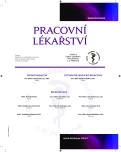Selected aspects in the lifestyle of truck drivers
Authors:
Kikalová Kateřina 1; Bendová Markéta 1; Slavíček Ondřej 2
Authors‘ workplace:
Katedra antropologie a zdravovědy, Pedagogická fakulta Univerzity Palackého v Olomouci, vedoucí pracoviště Mgr. Michaela Hřivnová, Ph. D.
1; Ústav matematiky a kvantitativních metod, Fakulta ekonomicko-správní, Univerzita Pardubice, vedoucí pracoviště doc. RNDr. Bohdan Linda, CSc.
2
Published in:
Pracov. Lék., 66, 2014, No. 1, s. 12-19.
Category:
Original Papers
Overview
Introduction:
The truck transport is a significant part of industrial evolution. The truck driving makes great demands on the drivers. It has been proved that the drivers are exposed to products of fuels, all body vibrations, heavy load carrying, stress, irregular alimentation and unsuitable sleep regimen. Several studies demonstrated higher morbidity in this specific group of employees.
Objective:
Since a higher morbidity of patients was demonstrated even in certain civilization diseases, which are also partly caused by the way of life, this study has been aimed at the lifestyle of truck drivers. The aim of the present work was to analyze and evaluate some aspects in the lifestyle of truck drivers.
Methods:
The study was carried out by a questionnaire survey. It included 391 respondents addressed within the framework of on-the-job training for professional qualification of drivers for truck driving. The authors determined the drinking regiment, regularity in alimentation, smoking, motion activity and duration of sleep.
Results:
The drinking regiment of 88.5% of respondents was considered sufficient, but most respondents have been taking meals irregularly and without sufficient amounts of vegetables. The extent of smoking in the observed group was slightly higher than that in the general population. Moreover, it has become obvious that 72.4% of respondents practiced walking for at least 30 minutes or three hours a week. The drivers younger than 60 years of age were proved to sleep a shorter time during weekdays than during the weekends by the Wilcoxon pair test.
Conclusion:
The results indicate, similarly to studies abroad, that lifestyle of the selected group of truck drivers are not optimal. It remains to be discussed in which way the working conditions and motivation of the drivers could be improved to have the space and will for improving their own lifestyle.
Keywords:
fright transport – drivers – lifestyle – smoking – sleep duration – drinking regimen - alimentation
Sources
1. Havlík, K. Psychologie v řidičské praxi. Praha: Vogel Medien International, 2011, 136 s.
2. Encycklopaedia of Occupational Health and Safety. ILO Geneva, 1998 (4 vydání).
3. Dahl, S., Kaerlev, L., Jensen, A., Tüchsen, F., Hannerz, H., Nielsen, P. S., Olsen, J. Hospitalization for lifestyle related diseases in long haul drivers compared with other truck drivers and the working population at large. Work, 2009, 33, p. 345–353.
4. Robinson, C. F., Burnett, C. A. Truck drivers and heart disease in the United States, 1979–1990. Am. J. Ind. Med., 2005, 47, p. 113–119.
5. Machová, J., Kubátová, D. a kol. Výchova ke zdraví. Praha: Grada Publishing, 2009, 296 s.
6. Čeledová, L., Čevela, R. Výchova ke zdraví. Praha: Grada Publishing, 2010, 128 s.
7. Hamish, M. The health and fitness of log truck drivers. [on line]. Log Transport Safety Council 2008. In: http://www.ternz.co.nz [cit. 2013-03-30]. Dostupné z www: http://www.ternz.co.nz/Publications/The%20Health%20and%20Fitness%20of%20Log%2.0Truck%20Drivers.pdf.
8. Taylor, A. H., Dorn, L. Stress, Fatigue, Health, and Risk of Road Traffic Accidents Among Professional Drivers: The Contribution of Physical Inactivity. Annu. Rev. Public Health, 2006, 27, s. 2.1–2.21.
9. Pastucha, D., Sovová, E., Malinčíková, J., Tichá, R., Talafa, V., Sova, M. Pohybové aktivity jako součást prevence kardiovaskulárních onemocnění v ordinaci praktického lékaře. Praktický lékař, 2010, 9, 8, s. 467–470.
10. Horáková, D., Sovová, E., Pastucha, D., Benešová, R., Kollárová, H. Rizikové faktory rozvoje inzulínové rezistence. Praktický lékař, 2011, 91, 10, s. 599–602.
11. Fořt, P. Výživa pro dokonalou kondici a zdraví. Praha: Grada, 2005, 181 s.
12. Výživová doporučení pro obyvatelstvo České republiky. Společnost pro výživu. [on line] publikováno 16. 4. 2012. [citováno 10. 9. 2013] dostupné na www: http://www.vyzivaspol.cz/rubrika-dokumenty/konecne-zneni-vyzivovych-doporuceni.html.
13. Kunová, V. Zdravá výživa. Praha: Grada, 2011, 2. vyd., 140 s.
14. Moreno, C. R. C., Carvalho, F. A., Lorenzi, C., Matuzaki, L. S., Prezotti, S., Bighetti, P., Louzada, F. M., Lorenzi-Filho, G. High Risk for Obstructive Sleep Apnea in Truck Driver Estimated by the Berlin Questionnaire: Prevalence and Associated Factors. Chronobiology International, 2004, 21, 6, p. 871–879.
15. Sovová, E., Zapletalová, B., Cipryanová, H. 100+1 otázek a odpovědí o chůzi, nejen nordické. Praha: Grada Publishing a. s., 2008, 79s.
16. Láchová, J. Evropské výběrové šetření o zdravotním stavu v ČR. EHIS CR. (Kouření a vystavení tabákovému kouři). 2011 [on line]. publikováno 20. 1. 2011, [cit. 9. 9. 2013]. Dostupné na www: http://www.uzis.cz/rychle-informace/evropske-vyberove-setreni-zdravotnim-stavu-cr-ehis-cr-koureni-vystaveni-tabakovemu-kouri.
17. Hobzová, M., Nakládalová, M., Kolek, V. Syndrom obstrukční spánkové apnoe a zdravotní způsobilosti k práci. Pracov. Lék., 2008, 60, 1, s. 17–21.
18. Bonnet, M. H., Arand, D. L. We are Chronically Sleep Deprived. Sleep., 1995, 18, 10, s. 908–911.
19. Haraldsson, P. O., Akerstedt , T. Drowsiness – greater traffic hazard than alcohol. Causes, risks and treatment. Lakartidningen, 2001, 98, 25, p. 3018–23.
19. Chráska, M. Metody pedagogického výzkumu. Praha: Grada Publishing a. s., 2007. 272 s.
Labels
Hygiene and epidemiology Hyperbaric medicine Occupational medicineArticle was published in
Occupational Medicine

2014 Issue 1
Most read in this issue
- Case report of a patient with perception hearing disorder
- Dynamic analysis of the foot load during gait in professional ballet dancers
- The correlation between symptoms and electromyography findings in workers exposed to vibration and overloading of upper limbs
- Exogenous allergic alveolitis in automobile industry – case report
